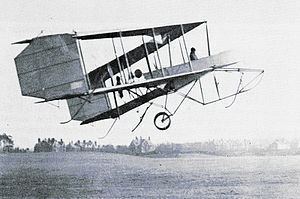Designer John William Dunne | ||
 | ||
The Dunne D.8 of 1912 was one of a series of tailless swept wing biplanes, designed by J. W. Dunne to have inherent stability. One of the few built was the only Dunne aircraft to fly, albeit very briefly at RAE Farnborough, under Government ownership. Others were used by the US Signal Corps and United States Navy and the short-lived Canadian Aviation Corps. It was the latter's first and only warplane.
Contents
Design and development
J. W. Dunne's first swept biplane wing aircraft, designed to have automatic stability, dated from his employment at the Balloon (later) Aircraft Factory at Farnborough during 1906–09. To preserve military secrecy testing was done at Blair Atholl in Scotland. After leaving Farnborough, Dunne set up a private company, the Blair-Atholl Syndicate Ltd. Its first aircraft was the Dunne D.5. When this crashed in 1911 it was rebuilt as the D.8. The two models shared very similar wings and the same engine, but the D.8 had a single pusher propeller instead of the chain-driven pair of the D.5. Their fuselages and undercarriages were also different.
The D.8 was a tailless four bay unstaggered biplane with its wings swept at 32°. Its constant chord wings were built up around two spruce spars, the forward one forming the leading edge. To help achieve stability the incidence and interplane gap decreased outboard, the former becoming negative. This washout on tips well behind the centre of gravity provided longitudinal stability in the same way as a conventional tailplane, set at lower incidence than the wings. Camber increased outwards. Simple, near parallel, pairs of interplane struts joined the spars. The outer interplane struts were enclosed with fabric, forming fixed side curtains that provided directional (yaw) stability. Wing tip elevons were used for control, operated by a pair of levers, one either side of the pilot. The D.8 initially used just a pair of these, mounted on the upper wing, a rectangular cutout in the side curtains allowing for their movement as on the D.5. Large parts of the aircraft were built by Short Brothers.
The D.8's water-cooled 4-cylinder, 60 hp (45 kW) Green engine directly drove a four-bladed pusher propeller, saving weight compared with the D.5's chain drive. Though it is not certain when the propeller was changed, most photographs show the Green engine driving a two-bladed airscrew. As a consequence of the propeller position the fuselage was shortened at the rear; it was also extended in the nose. This first D.8 seems to have been a single-seater like its D.5 predecessor, the pilot sitting at mid chord.
Contemporary sources remarked on the complexity of the D.8's undercarriage, which combined a narrow track pair of sprung wheels pair with wingtip skids. Part of its complication came from opposing springing in the absence of dampers, and part from an elaborate anti-noseover skid.
In this form the D.8 first flew in June 1912 at Eastchurch. It attended the Larkhill Military trial in August 1912, though it did not take part in the competition. It flew regularly at Eastchurch through 1911 and 1912 and was still active there in November 1912. Despite the two handed arrangement of the D.8's controls, the one-handed Capt. A.D. Carden gained his Royal Aero Club Aviator's Certificate on it in June 1912.
It is not known if this machine was later modified aerodynamically, but by August 1913 the Green engine had been replaced by an 80 hp (60 kW) 7-cylinder Gnome rotary engine. This much shorter engine also powered the second aircraft, which was a two-seater with the pilot placed just ahead of the wing leading edge and the passenger (who had dual control) at the trailing edge. There were now control surfaces on both upper and lower wings, the side curtains having a pair of tapered notches to allow them to move. Each of the upper wings carried a pair of elevons, nearly doubling the control surface area, though it is not certain if these moved as one or differentially. It first flew, with Felix at the controls, on 18 October 1913.
In August 1913 Commandant Felix piloted a D.8 across the English Channel from Eastchurch to Villacoublay. Nieuport had obtained a licence to build the D.8 and Felix gave demonstration flights in France on their behalf. A Nieuport-built Dunne appeared at the Paris Aero Salon in December 1913. Like the second D.8 it was a Gnome powered two-seater, but with significant differences both aerodynamically and structurally. It combined the double upper wing elevons into a single surface and had very rounded rear wingtips. The fuselage was slightly modified and built around steel tubes rather than wood. The interplane struts were streamlined steel tubes. It also had a strikingly simplified undercarriage.
Dunne had obtained a War Office order for two D.8s, though one was cancelled because of late delivery. One, possibly the machine flown in October 1913 and certainly similar to it, was delivered to Farnborough on 3 March 1914. It made several flights on 11 March piloted by N.S.Percival, who had flown the first D.8 many times at Eastchurch and was now a RFC officer. Though it carried the RFC number 366, there is no record of it flying again though it may have survived until at least the summer of 1914. The general judgement was that in the search for balance between stability and controllability, the Dunne design overemphasised the former.
Variants
Specifications (second aircraft)
Data from Goodall & Tagg 2001, p. 105
General characteristics
Performance
